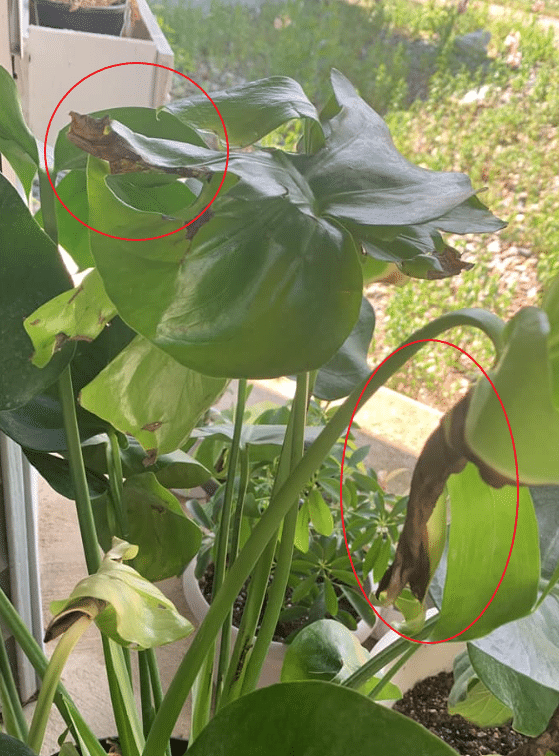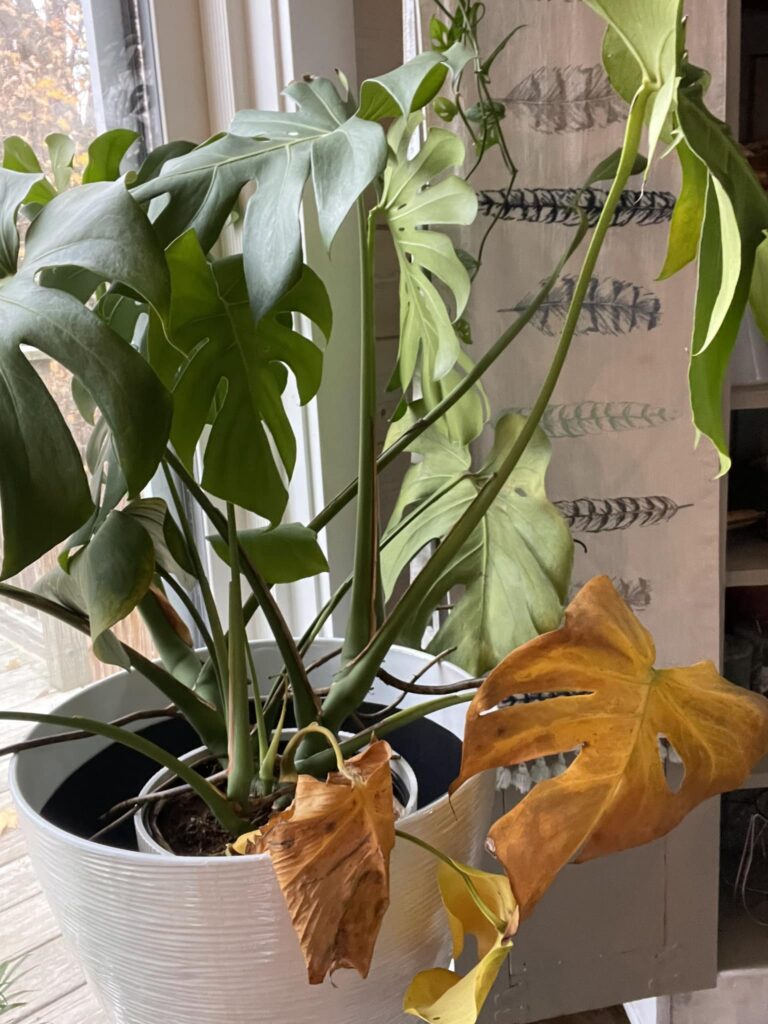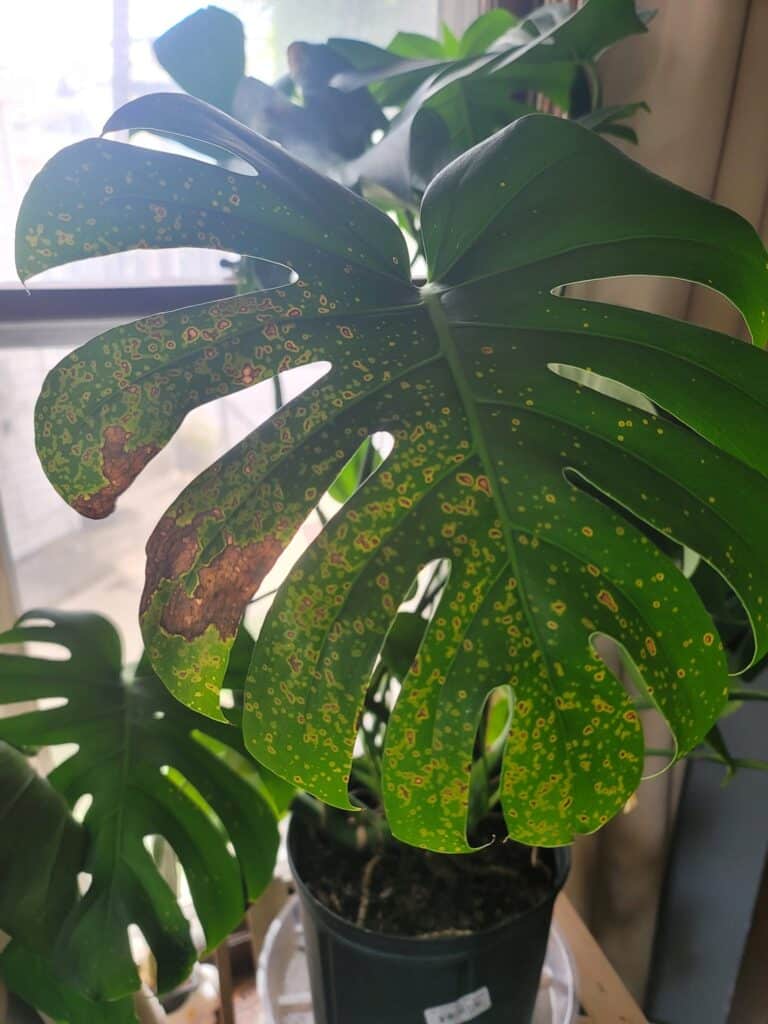Joining a Monstera club is exciting, but are you equally distressed by the unsightly Monstera brown leaves appearing out of nowhere?
Be wary of browning, which may indicate that your Monstera is a victim of unfair practice.
However, do not worry because these problems are quickly solvable when caught and treated early.
Table of Contents Show
What Causes Monstera Leaves To Brown?
Monstera is known for its Swiss-cheese-shaped leaves with deep lobes.
The healthy Monstera leaves would span up to 3 feet as they grow, attaining a vibrant, glossy green, ornamental appearance.
However, these tropical beauties deserve proper watering, lighting, and humidity levels, without which their leaves will falter.
Some early indications of problems include brown spots, leaf edge or tip browning, or overall browning (rare).
If you witness these signs, the primary step would be to identify the cause and apply the appropriate solution ASAP.
1. Overwatering Issue
Monstera leaves turning brown and yellow indicate an overwatered plant.
Seeing dark brown spots or patches likely mean it is getting too much water or is suffering from root rot.

Some early signs include mushy stems, yellowing bottom leaves, and brown patches.
Soggy soil will become a hotbed for pathogens without timely treatment, increasing the risk of fungal or bacterial infection.
Therefore, be wary of overwatering your Monstera plant and treat the issue early to avoid grave problems.
If you witness Monstera brown stems, know your plant suffers from severe root decay, which may require disposing of the entire plant.
2. Under-watering Issue
Although rare, under-watering your Monstera plant may invite browning of leaves due to transpiration, which can occur due to various factors.
- Inconsistent watering routine: Irregular or infrequent watering leads to dried soil and poor drainage.
- Improper watering techniques: Watering too lightly or not providing enough water in the growing session can result in insufficient hydration for the plant.
- Environmental factors: Similarly, high temperatures, low humidity, or increased air circulation can cause the soil to dry out faster.
Monstera leaves curling and new leaf brown tip are often the early signs of the under-watered plant.
You will witness the edges of the leaves becoming dry.
3. Too Much Sun
Too much sun harms tropical houseplants like Monstera because they naturally thrive as shade plants.
Is your Monstera leaves turning brown shortly after yellowing or producing paler green leaves? The chances are, it is transpiring too quickly.
Here are a few tell-tale signs:
- Leaf scorching: The leaves may develop brown or yellow patches, especially on the side facing the sun.
- Leaf bleaching: The leaves may appear pale or faded, losing their vibrant green color.
- Curling: The leaves will curl inwards to preserve water due to overexposure to intense sunlight.

Remember, Monstera does well in 6 or more hours of indirect, filtered, or diffused sunlight each day.
4. Not Enough Humidity
A common problem with indoor plants like Monstera is dry air. If, for some reason, the air is dry, the plants can develop brown spots due to a lack of humidity.
Monstera leaves evaporate water through the stomata, and some moisten the leaf surface, keeping them wet.
Dry air will dry out the leaf surface quicker than it can replenish, leading to browning leaf edge, drooping, and sometimes stunted growth.
Keep in mind low humidity increases susceptibility to pests like spider mites and mealybugs.
5. Excess Fertilization
Overfertilization is a primary culprit behind multiple severe problems with houseplants.
Monstera is no different. A not-so-heavy feeder, it does well with balanced fertilizer applied monthly in the growing season.
Overfeeding the plant, especially with undiluted or synthetic fertilizer, will result in chemical burns, leading to Monstera leaves dying.
Some early signs include leaf burn on the tips or edges and unusual color change (yellowish or brownish surface).
However, you can promptly solve this issue and rescue your Monstera if you quickly identify the early signs.
Otherwise, you will witness premature leaf shedding and root damage, which are irreversible.
6. Transplant Shock
Yes, Monstera plants can experience transplant shock when moved or repotted.
To your dismay, it is sometimes unavoidable as you must repot the Monstera plant every two years or so.
Either way, the plant will stop growing, start wilting (drooping), and change color.
The Monstera leaves turn brown in the middle, where some leaves will shed to adjust to changing environment.
Remember, sometimes, even minor changes in growing conditions can stress the plant, which gets fixed on its own.
7. Pests and Diseases
Due to inadequate care and maintenance, many garden pests and diseases can infect Monstera plants.
One of Monstera’s earliest signs of pest and disease infestation is changing leaf color and appearance.
The leaves will turn primarily brown and shrivel; some will produce bumps, fenestration (holes), and similar visible signs.

Here is a list of pests and diseases which can likely infect Monstera plants.
| Agents | Signs |
|---|---|
| Spider Mite | -Brown, little tiny spiders found on leaf undersides -The leaves will turn brown and shrivel |
| Scale Insects | -Flat and round, signified by white and yellowish spots all around the plant -Droopy leaves accompanying white bumps |
| Thrips | -White with tubular-shaped bodies. -Foliage become brownish-yellow color and fragile |
| Mealybugs | -White, cottony masses on the leaves, stems, or leaf axils -Yellowing or browning of the foliage |
| Pythium Root Rot | -The fungal disease that causes rapid root rot -Irregular yellow or brown patches will appear on the leaves |
| Phytophthora Root Rot | -The fungal disease that develops root and crown rot -Leaf margins develop brown, necrotic symptoms typical of salt burn |
| Leaf Spot Diseases | Circular brown spots on the leaves that may enlarge or develop a yellow halo, browning and eventual leaf drop |
How To Save Monstera Brown Leaves?
Browning starts off with the tip of the Monstera leaves and spreads through the edges until the plant dies.
So, you need to identify the individual cause of the problem and fix them with problem-specific mitigations.
A. Overwatering
- If you spot early signs, cut back on watering immediately and let the pot out in the indirect sun to dry out.
- Trim off excessively browned leaves and mushy stems to help the plant recover.
- If you suspect root rot, carefully remove it from the pot, trim away any affected roots, apply fungicide, and repot in fresh potting soil.
B. Underwatering
- Give it a deep watering session by slowly pouring water onto the soil until it starts to flow out of the drainage holes, ensuring the root ball is thoroughly hydrated.
- Repeat the process after a short interval to ensure proper hydration if the soil absorbs water quickly.
- Mist the Monstera leaves using a spray bottle filled with fresh water to hydrate them.
- The dead edges will remain dead; hence feel free to trim away dead and decayed parts.
C. Excess Sunlight
- Immediately move the plant to shade or a spot with indirect sunlight, such as an east or west-facing window.
- Trim away affected foliage to redirect the energy toward healthy new growth.
- If placed near a south-facing window, use curtains or blinds to diffuse the light and reduce its intensity.
Moving Monstera outdoors? Instead of moving them immediately, gradually increase sun exposure over weeks and avoid the mid-day sun, especially initially.
D. Low Humidity
- Get rid of severely damaged leaves and stems to help restore the plant’s health.
- Next, move it closer to a room humidifier and maintain 60-65% humidity.
- Water the soil thoroughly until the excess drains out, and mist the leave using a spray bottle filled with fresh water.
E. Overfertilization
- Leach excess salts and nutrients from the soil by thoroughly watering the plant until the excess water runs out of the drainage holes.
- Repeat this process a few times to flush out accumulated fertilizer residues and re-water only after the soil has significantly dried.
- Completely halt fertilization for some time to allow the plant to recover and check for progress.
F. Repotting & Transplanting Shock
- The only solution is to minimize further stress and allow it to recover.
- Give it a thorough watering immediately to rehydrate the root system, and provides some relief from the shock.
- Direct sunlight can exacerbate transplant shock, so avoid bright light for a while.
- Raise the humidity around the plant by misting the leaves or using a humidifier to aid recovery.
- Refrain from fertilizing for a bit to help it recover and establish new roots.
G. Infestation & Diseases
- Isolate the infected plant and prune the infected stem and foliage using sterilized scissors.
- Trimming Monstera brown leaves will be an ideal option to reduce further infestation.
- Wash the plant using a cotton swab dipped into neem or horticultural oil to kill the pests effectively.
- In the case of a commercial garden, try a malathion solution or pyrethrin if the situation does not subside.
How To Prevent Monstera From Getting Brown Leaves?
Monsteras are native to tropical and humid environments, which may require considerable watering and humidity. But make sure they enjoy the place with the following tips.
- Incorporate perlite or coarse sand into the potting mix to improve soil aeration and drainage.
- Allow 1-2 inches of topsoil or potting mix to dry before watering again. Stick your finger into the soil or use a soil moisture meter.
- Adjust the watering routine and habitually deep water the Monstera plant when the top 1-2 inches of soil dries out.
- Regularly rotate the Monstera to ensure even light distribution and prevent one side from receiving excessive sunlight.
- Place the plant in a humidifying tray or pebble tray throughout summer to boost the humidity in the air.
- Use a humidity dome or tent to create a more controlled microclimate if the relative humidity drops below 40%.
- Follow the recommended fertilizer application guidelines for Monstera.
-
Apply balanced liquid fertilizer 20-10-20, and dilute the solution to half-strength before applying (bi)monthly from March until June.
- Adjust the frequency and duration of fertilization based on the plant’s response and growth.
- Avoid overwatering or misting the plants in the evening hours. Say No to excess moisture and humidity!
- Always use certified, disease-free potting mix and occasionally wash the plant with neem oil in the growing season.
From Editorial Team
Conclusion!
Some natural Monstera Leaves browning is unavoidable as old foliage will decay and drop to make way for new.
The ghastly sight of browning leaves in an active growing season is uncommon; you should carefully look into the matter.
Pay special attention to Monstera’s watering, feeding, lighting, and humidity requirements, and never overdo anything.
